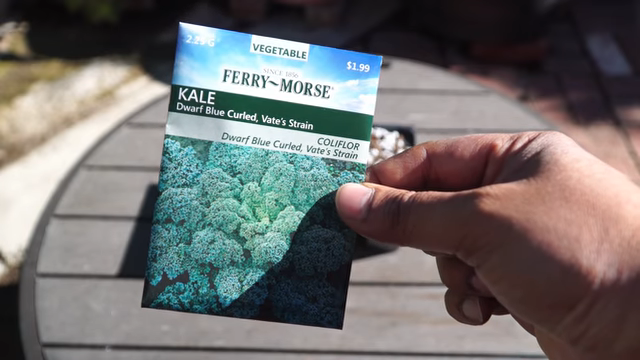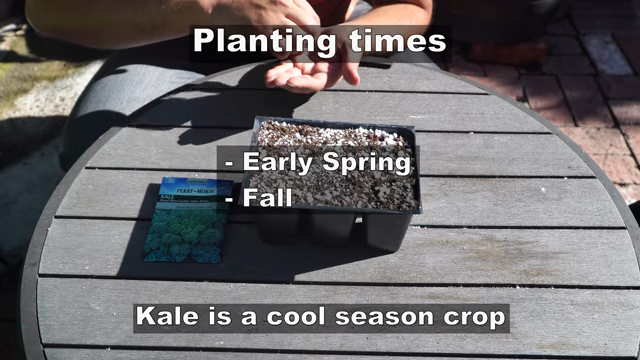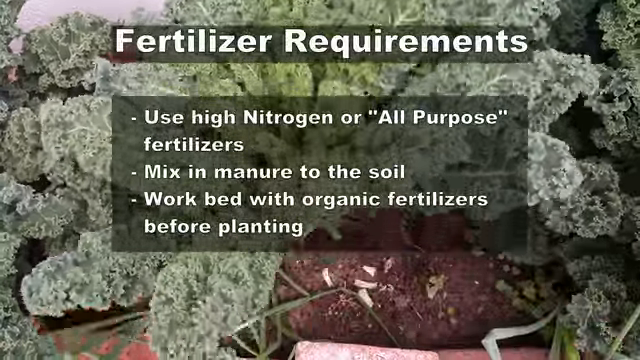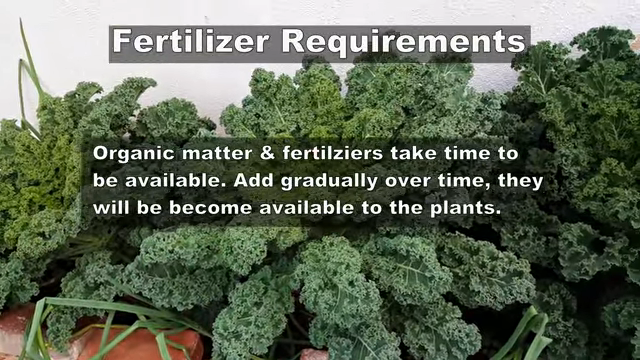In today's episode we look at growing kale a cool season crop that is a member of the cabbage family and a healthy leafy green vegetable to grow in your garden.
Now although you can direct sow kale seeds I recommend that you start your seeds indoors or in these seed starting kids.
The variety of kale that I'm going to show you here is called the dwarf blue variety of kale which is a popular variety.
Some of the other kale varieties that are available.
In places like Southern California you can plant kale pretty much around the year but kale in general is a cool season crop.
So it's best if you plant them in early spring or fall.
Planting Times
If you plant them in spring you can harvest all through spring and summer and if you plant them in the fall you can harvest them right through fall and even in winter.
Now we sowed our seeds in this seed starting kit here it's these six cells we sawed about two seeds in each cell and the mix that we are using here for the seed starter is a mix of peat moss perlite and worm castings.
Seed Starting MIX
Now you can use coconut coir if you have it instead of peat moss but in general this is a good seed starting mix.
Now in just a few weeks about four to five weeks you will see that the plants have germinated the seeds have germinated and the plants have now come up and at this stage you can start transplanting them.
I am going to be transplanting these kale seedlings into this whisky barrel container.
SOIL
You can grow a lot of these kale plants into this key barrel container.
And as grown kale and whiskey barrel containers in other regular containers as well as in raised beds.
And it grows very well no matter where you grow it.
Kayle is an excellent plant to grow in the home garden because there are very few problems with growing kale and as you'll see it produces an abundant harvest.
Watering
And as far as watering kale goes you need to water it well during planting and then depending on the temperatures in your area you can follow a watering schedule for your kale plant.
Now here you can see that we are growing this kale plant in a smaller container and it grows perfectly well for a container of size of about 5 gallons you can grow one kale plant as you can see here it grows very well.
So I know a lot of folks just use 5 gallon containers and grow one kale plant in each one of them and that's a very good approach to growing kale it will give you an abundant harvest.
Now although kale can be grown in full Sun it will also grow very well in partial Sun.
Now when we talk about partial Sun it's important to remember that it still needs about four hours of sunlight every day.
And less than four hours of sunlight you might still be able to get through by growing the plant but the yield would not be that good.
There are mainly two types of ends that I've seen on kale the first one is what you see here the caterpillar or the looper boom.
And this will chew away at your kale leaves so what I do is I just shake the plant vigorously just like that and any caterpillars that are there on the plant are going to fall down and you can pick them up.
And you can even handpick those caterpillars they are easy to hand back since they are pretty big.
I've also seen a feds on the KL plant now aphids generally show up later in the season when it starts getting warmer like late spring or early summer you can see a feds.
And what I usually do is if I get a feds I just wash the plant with the water hose I just wash it down all the aphids go away and then I just remove the leaves that I don't need.
Types Of Kale
Now let's take a look at the types of kale that we have.
Curly kale is the most common kale variety the dwarf Siberian and the dwarf blue are common curly kale varieties.
And then we have the loss in Tokyo which I will be showing you in today's video the red Russian and red bore kale are another two varieties of kale that you might find in a grocery store.
I have not grown these two kale varieties but will be doing so soon in the future so what you're seeing here is the curly kale variety so the common varieties are the dwarf blue or the dwarf Siberian kale is an excellent variety to grow very delicious as well.
Curly Kale
And this is the loss in Tokyo as you can see here the leaves look very different yet a dark green and they're flatter compared to the curly kale variety.
And here you can see that once the kale plant grows pretty large you can get an abundant harvest from just a few kale plants.
Now you don't really need a lot of kale leaves unless you are eating it every day but still the kale plant does produce a lot of leaves.
So let's look at a harvest here here we are harvesting the curly kale this is the dwarf Siberian or the dwarf blue variety they're very similar varieties great kale variety to grow now when you're growing kale you want to make sure that you do not harvest from the top part of the plant you want the top part of the plant to grow larger and not branch out.
So unlike most of the vegetables that you harvest you want your kale to grow in a straight line producing leaves all around it and here is the Las in Tokyo being harvested dark green leaves flutter leaves delicious varieties.
Now when you are growing organically at home you might see a few holes in your leaves here and there don't worry too much about it just use the leaves that look good to you and as long as you're hand picking your insect and watching your plants on a regular basis you should be able to grow very good healthy kale leaves in your garden without a lot of insect damage.
Fertilizer Requirements
Now since kale is a leafy green you need a fertilizer which is high in nitrogen you can use liquid fertilizers that are high in nitrogen all-purpose fertilizers or any fertilizer that's high in nitrogen.
If you are using organic fertilizers just make sure you work it into the soil at least four to six months before planting and that will give you the best kale that you've ever grown.
So there we have it folks that was our episode on growing kale I hope I've answered most of your questions for growing kale if you have any more questions do put them in the comment box below and let us know your experiences of growing kales we'll







